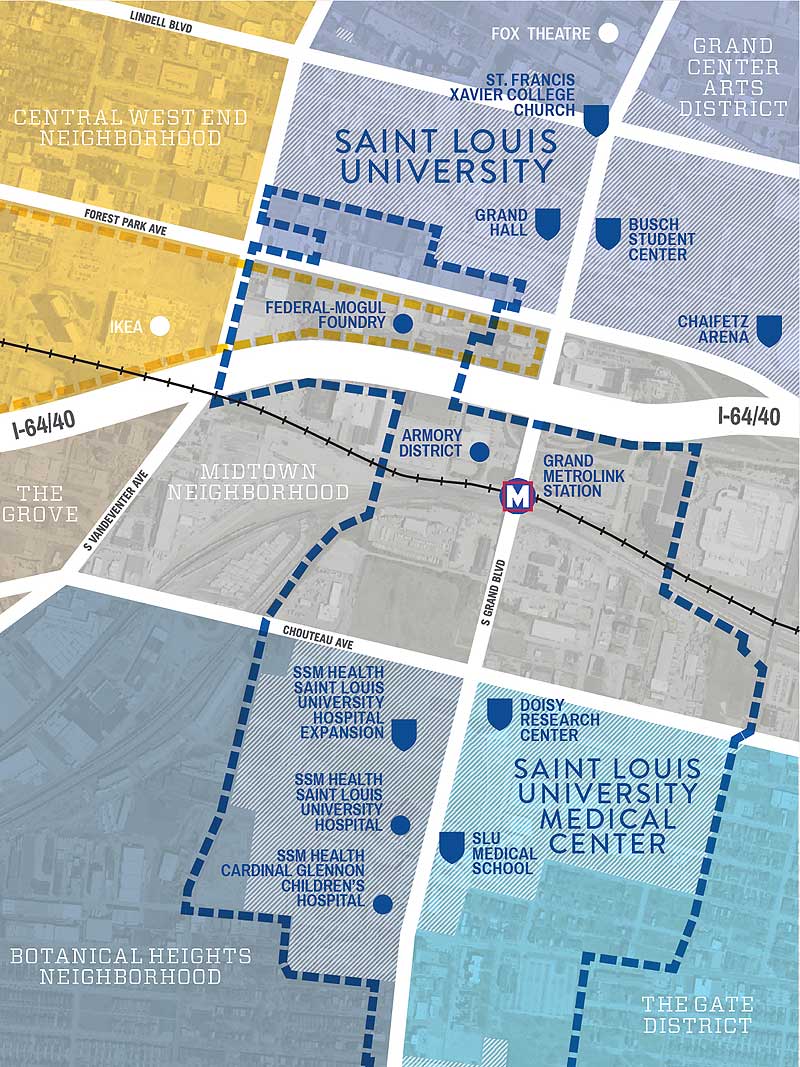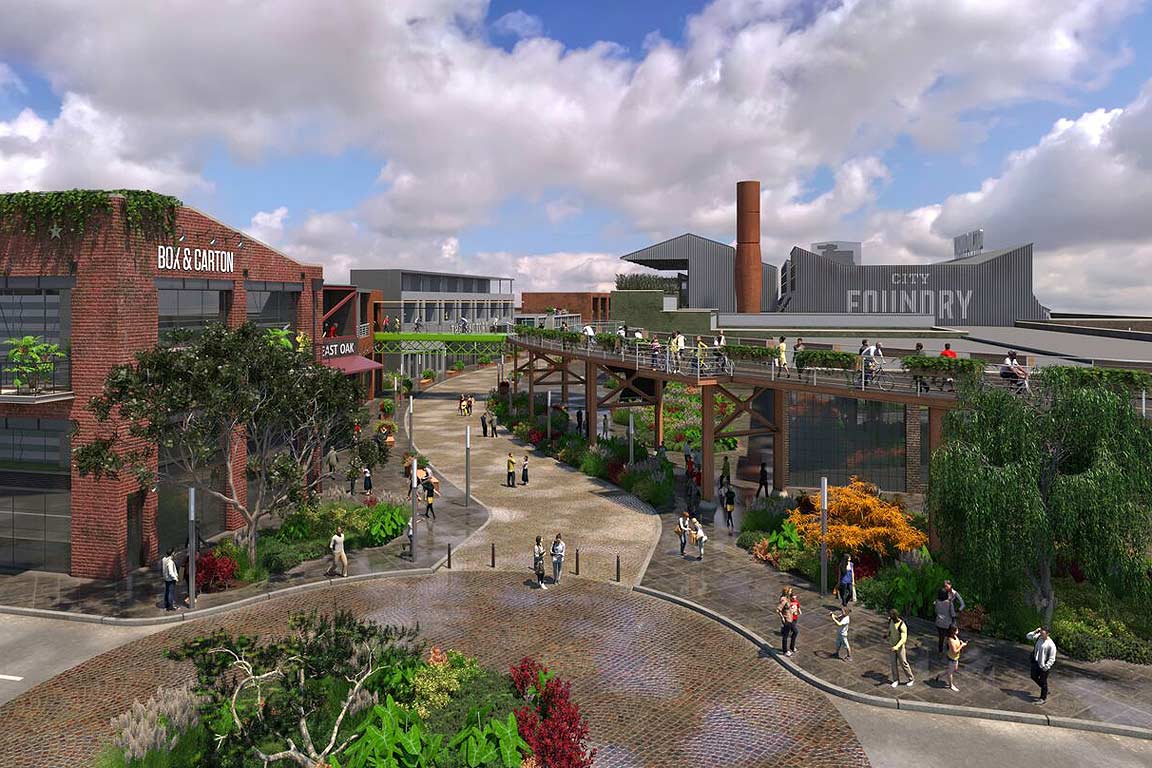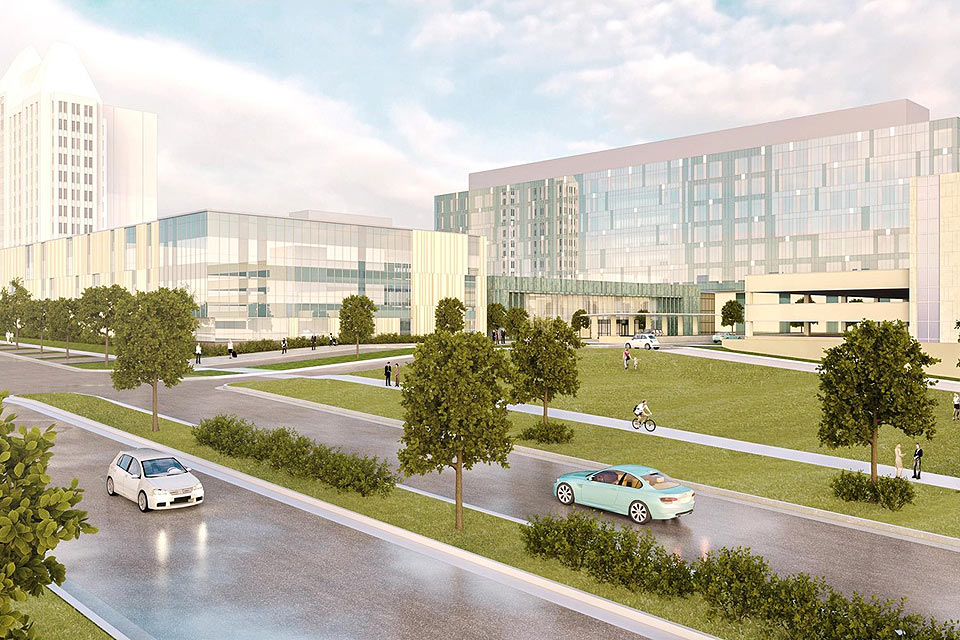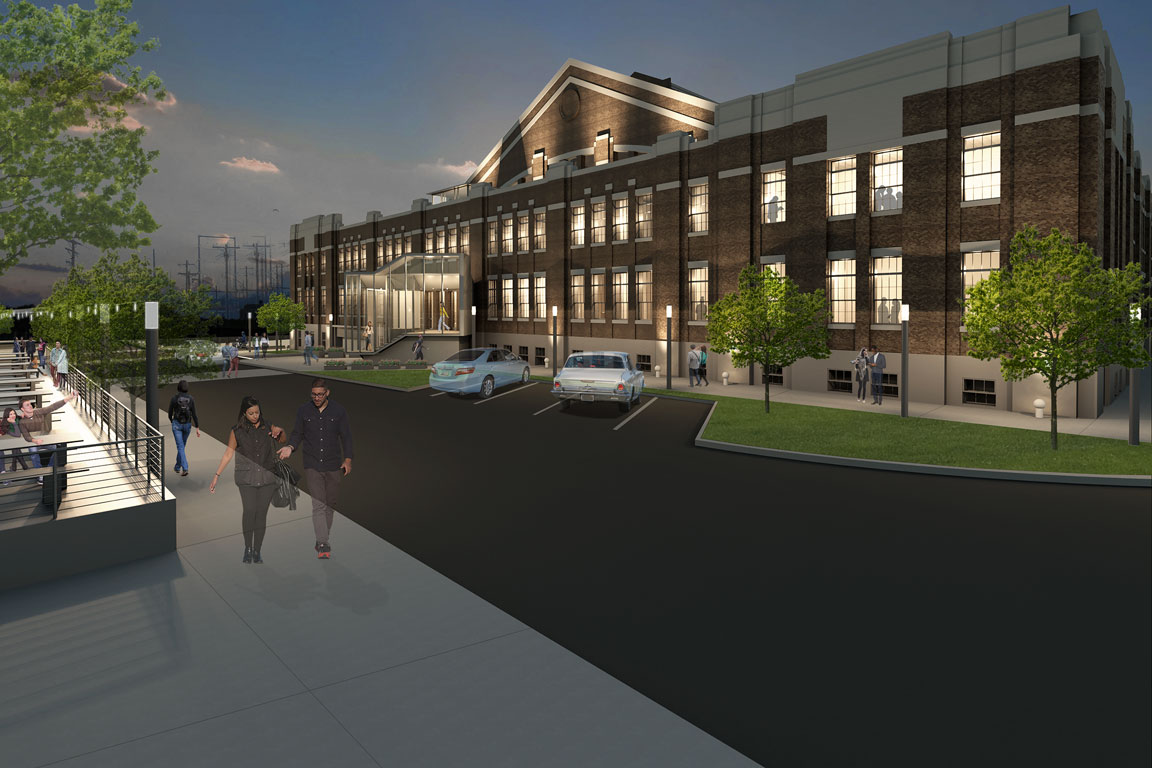Redevelopment Plan Seeks To Encourage Investment in Area, Connect Campus
When Saint Louis University moved its burgeoning downtown campus two and a half miles west in 1888, the entire enterprise — classrooms, library, laboratory, chapel, offices and Jesuit residence — fit in a single four-story, red-brick building.
Over the next century, the University developed far beyond DuBourg Hall, expanding in every direction and becoming an integral part of the community. SLU grew with the area, and when it needed to be picked up, SLU stepped up, committing to be a catalyst for renewal in Midtown St. Louis.
Now, as Saint Louis University prepares for its bicentennial and the next century of progress, the University has unveiled plans for campus and beyond. Take a look at the grand scheme of things.
A Long-Term Approach
At a time when non-SLU developers are planning nearly $1 billion in new projects in St. Louis’ central corridor, SLU has shared its vision for nearly 400 acres in Midtown as it seeks greater influence over development in the future.
The University recently formed a redevelopment corporation through Chapter 353 of the Revised Statutes of Missouri — known as the “Urban Redevelopment Corporation Law.” As the area’s master developer, SLU will work to bring in other parties to invest in the area — with authority to grant limited financial incentives. SLU also will have the final say in new projects.
“Saint Louis University has long been a leader in the city and an example for other institutions,” said Brooks Goedeker (Grad SW ’04), executive director of the redevelopment corporation. “As SLU approaches its 200-year anniversary, what better way to show that the University is as relevant and innovative as ever than by working to improve the communities around it.”
The University’s redevelopment plan was unanimously recommended by the St. Louis Planning Commission and approved the Board of Aldermen last fall. In broad strokes, the plan lays out proposed uses within the redevelopment area. These include:
- Medical and educational uses including offices and training facilities for those in the health care and life sciences. Classrooms and related instructional, laboratory, research, hospice, nursery and day care spaces; and pharmacy facilities
- Office facilities for private, public and nonprofit institutions, businesses and agencies; research facilities; retail, dining, entertainment and other services; hotel and conference facilities; recreational and community facilities; and parking
- New residential housing near the SLU Medical Center, where it’s estimated that 60 to 80 single-family or low-density dwelling units could be constructed on vacant lots in the area
The University is taking a long-term approach as it moves forward. “We need to plan for both the near and distant future,” said David Heimburger (Cook ’85), SLU’s vice president and chief financial officer, who also is leading the redevelopment effort. “We have to think about the next 10 years and also about what SLU will be in 50 or 100 years.”
A Strategic Priority for SLU
SLU’s strategic plan calls for the University to become “a leader in just land use and responsible urban design.” To fulfill this objective, SLU is developing its first campus master plan in 27 years.
“Following the development of the previous campus master plan 27 years ago under the leadership of President Emeritus Father Lawrence Biondi, S.J., our Midtown campus saw exponential growth in size and an increase in civic partnerships,” said University President Dr. Fred P. Pestello. “To meet the ever-changing needs of our community, and ensure we stay true to our eternal and noble mission, we must build upon our history and envision our future.”
While working on the campus master plan, Heimburger said SLU saw a need to better connect its north and south campuses, which are separated by the Grand Bridge and a swath of industrial or vacant properties. From this need, the idea for forming a 353 redevelopment corporation was born.
“When I arrived at SLU, I was approached by many members of the SLU community with the need to develop a plan for the physical future of the University,” Pestello said. “The reasons were compelling to the point that Midtown development became a focal point of the strategic plan.”
Through the Midtown development effort, Heimburger said SLU hopes to spur projects that will help unify the campus and attract services and venues that will benefit students, patients, faculty and staff, as well as local residents.
“Many portions of the redevelopment area are in tremendous need of investment, especially the areas that have been industrial for more than a century,” Heimburger said. “We’re looking forward to working with our neighbors and community partners to plan for the revitalization of the area.”
The redevelopment plan also notes that the University hopes to construct a major educational facility on the southwest corner of Grand Boulevard and Chouteau Avenue — the site of the former Pevely Dairy industrial complex — in the future.
With SLU looking to reduce costs, grow revenues and build a more efficient and effective organization through the Operational Excellence program (for more see page 4), Heimburger said it is important to note that creating and administering a redevelopment corporation is expected to be a budget-neutral operation, meaning that the project will have no impact on SLU’s budget and will not create a deficit.
The Redevelopment Area
The boundaries of the redevelopment area stretch from 39th Street, Spring Avenue and Vandeventer Avenue on the west; to Compton Avenue on the east; and from Laclede Avenue and Interstate 64 on the north; to Park Avenue and Interstate 44 on the south.

The area encompasses the future home of a new $550 million hospital and outpatient center that SSM Health is planning to build along south Grand Boulevard, adjacent to the current SSM Health Saint Louis University Hospital (see below). As the University’s health care partner, SSM Health has a seat on the board that governs SLU’s redevelopment corporation.
Also included is the former site of the Federal-Mogul foundry, where there are plans to develop a new food hall flanked by offices, retail shops and apartments, as well as the St. Louis Armory on Market Street, where developers hope to build a new entertainment and employment complex featuring a craft brewery, rooftop bar, hotel and more.
Immediately west of the proposed redevelopment area is the Cortex Innovation Community, of which SLU is a founding institution. Formed in 2002, Cortex is a $550 million, 200-acre innovation hub and technology district that has 4,200 technology-related jobs. More than 250 companies call Cortex their home.
Pestello has witnessed Cortex’s progress firsthand as the vice chair of the organization’s board. “Cortex’s success is inspirational to SLU and to St. Louis as a whole,” Pestello said. “When I think about the cultural conditions and community efforts that led to Silicon Valley growing and developing into what the world knows it to be today, I cannot help but see analogues to the work being done here in St. Louis.”
With its proximity to Cortex, as well as the Grand MetroLink Station, the area could provide additional opportunities for technology-related and transit-oriented developments.
Community Input
Community engagement is an important part of the process, according to Heimburger. He said that SLU has already been in contact with a number of key property owners in the 353 redevelopment area, including those behind the foundry and armory projects.
“Recently, we were approached by SLU leadership about the possibility of including our City Foundry development in the new SLU 353 redevelopment plan,” said Steve Smith, founding principal and CEO of the Lawrence Group. “We enthusiastically agreed.
“We believe that this new redevelopment area will encourage and facilitate the type of investment and development that will be both collaborative with City Foundry as well as enhancing the substantial investment that we are already making.”
In addition to business development, residential neighborhoods in the Gate District and the Tiffany neighborhood near SLU’s south campus fall within the proposed area. In January, the University held an open forum for residents and other stakeholders. He added that no residents are expected to be displaced as part of the plan.
“The plan harkens back to the Jesuit tradition,” Goedeker said. “To me, ‘living for others’ means helping to make communities better and more productive for every citizen.”
Additionally, the University plans to form an advisory board made up of area residents and business owners, along with city residents who may have expertise in social services, transportation and other important issues.
While the redevelopment corporation gives SLU oversight of future development projects in the area, Heimburger noted that the University did not seek eminent domain powers to condemn and acquire property from private owners.
“We have been in St. Louis for nearly 200 years, and we are investing in the future of our city with our neighbors,” Heimburger said. “We want to help make St. Louis a better place to live, learn and work.”
This article originally appeared in the spring 2017 issue of Universitas, SLU's award-winning alumni magazine.




















